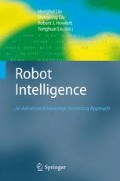Abstract
While camera calibration is a fundamental yet challenging problem for 3D measurement, it has attracted intensive attention from 3D vision community. In this paper, we propose a new model to characterise camera distortion in the process of the camera calibration. This model attempts to blindly characterise the overall camera distortion without taking the specific radial, decentring, or thin prism distortion into account. To estimate the parameters of interest, the well-known Levernburg-Marquardt algorithm is applied. To initialise the Levernburg-Marquardt algorithm, the results from the classical Tsai algorithm are estimated. After both the camera intrinsic and distortion parameters have been estimated, the distorted image points are corrected using again the Levernburg-Marquardt algorithm initialised by these distorted image points themselves. The performance of algorithms is measured as absolute and relative correction errors and collinear fitting errors. The experimental results based on both synthetic data and real images show that the proposed algorithm often successfully characterises the camera overall distortion, producing encouraging results for camera calibration and correction.
Access this chapter
Tax calculation will be finalised at checkout
Purchases are for personal use only
References
Andreetto, M., Brusco, N., Cortelazzo, G.M.: Automatic 3D modelling of textured cultural heritage objects. IEEE Trans. Image Process. 13, 354–369 (2004)
Bolles, R.C., Baker, H.H., Hannah, M.J.: The JISCT Stereo Evaluation. In: Proceedings of the ARPA Image Understanding Workshop, pp. 263–274 (1993)
Bougnoux, S.: From projective to Euclidean space under any practical situation, a criticism of self-calibration. In: Proceedings of the ICCV, pp. 790–796 (1998)
Claus, D., Fitzgibbon, A.W.: A rational function lens distortion model for general cameras. In: Proceedings of International Conference on Computer Vision and Pattern Recognition, pp. 213–219 (2005)
Devernay, F., Faaugeras, O.: Automatic calibration and removal of distortion from scenes of structured environments. Proc. SPIE 2567, 62–72 (2006)
Devernay, F., Faugeras, O.: Straight lines have to be straight. Mach. Vis. Appl. 13, 14–24 (2001)
Douxchamps, D., Chihara, K.: High-accuracy and robust localization of large control markers for geometric camera calibration. IEEE Trans. Pattern Anal. Mach. Intell. 31, 376–383 (2009)
Farid, H., Popescu, A.C.: Blind removal of lens distortion. J. Opt. Soc. Am. A 18, 2072–2078 (2001)
El-Melegy, M.T., Farag, A.A.: Nonmetric lens distortion calibration: closed-form solutions, robust estimation and model selection. In: Proceedings of International Conference on Computer Vision, pp. 554–559 (2003)
Fitzgibbon, A.W.: Simultaneous linear estimation of multiple view geometry and lens distortion. In: Proceedings of International Conference on Computer Vision and Pattern Recognition, pp. 125–132 (2001)
Hartley, R., Kang, S.B.: Parameter free radial distortion correction with center of distortion estimation. IEEE Trans. Pattern Anal. Mach. Intell. 29, 1309–1321 (2007)
Heikkila, J., Silven, O.: A four-step camera calibration procedure with implicit image correction. In: Proceedings of International Conference on Computer Vision and Pattern Recognition, pp. 1106–1112 (1997)
Heikkila, J.: Geometric camera calibration using circular control points. IEEE Trans. Pattern Anal. Mach. Intell. 22, 1066–1077 (2000)
Kim, J.-S., Kweon, I.S.: Camera calibration based on arbitrary parallelograms. Comput. Vis. Image Underst. 113, 1–10 (2009)
Liu, Y., Al-Obaidi, A., Jakas, A., Li, L.: Accurate camera calibration and correction using rigidity and radial alignment constraints. In: Proceedings of International Symposium on 3D Data Processing, Visualization and Transmission, pp. 145–152 (2008)
Ma, L., Chen, Y., Moore, K.L.: Flexible camera calibration using a new analytical radial undistortion formula with application to mobile robot localization. In: Proceedings of 2003 IEEE International Symposium on Intelligent Control, pp. 799–804 (2003)
Pollefeys, M., Koch, R., Gool, L.V.: Self-calibration and metric reconstruction in spite of varying and unknown intrinsic camera parameters. Int. J. Comput. Vis. 32, 7–25 (1999)
Tardif, J., Sturm, P., Roy, S.: Self-calibration of a general radially symmetric distortion model. In: Proceedings of the European Conference on Computer Vision, pp. 186–199 (2006)
Tsai, R.Y.: A versatile camera calibration technique for high-accuracy 3D machine vision metrology using the off-the-shelf TV cameras and lenses. IEEE J. Robot. Autom. 3, 323–344 (1987)
Weng, J., Cohen, P., Herniou, M.: Camera calibration with distortion models and accuracy evaluation. IEEE Trans. Pattern Anal. Mach. Intell. 14, 965–980 (1992)
Zhang, Z.: A flexible new technique for camera calibration. IEEE Trans. Pattern Anal. Mach. Intell. 22, 1330–1334 (2000)
Author information
Authors and Affiliations
Corresponding author
Editor information
Editors and Affiliations
Rights and permissions
Copyright information
© 2010 Springer-Verlag London Limited
About this chapter
Cite this chapter
Liu, Y., Al-Obaidi, A., Jakas, A., Liu, J. (2010). A Fraction Distortion Model for Accurate Camera Calibration and Correction. In: Liu, H., Gu, D., Howlett, R., Liu, Y. (eds) Robot Intelligence. Advanced Information and Knowledge Processing. Springer, London. https://doi.org/10.1007/978-1-84996-329-9_8
Download citation
DOI: https://doi.org/10.1007/978-1-84996-329-9_8
Publisher Name: Springer, London
Print ISBN: 978-1-84996-328-2
Online ISBN: 978-1-84996-329-9
eBook Packages: Computer ScienceComputer Science (R0)

